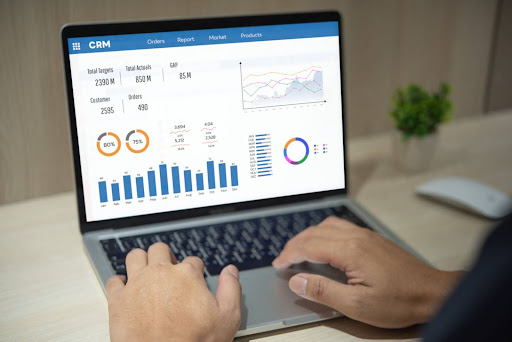9 Reasons Your B2B Lead Generation Strategy Isn't Working [+ 9 Proven Solutions]
Because you’re interacting with busy professionals who want specialized solutions, generating B2B leads might be challenging. Like fishing in a busy pond full of finicky fish, you have to have patience, timing, and the perfect bait in order to bring them in.
– 15 mins

No, it’s not just you; lead generation is downright difficult.
Now, we could blame the perpetual struggle of generating leads on digital noise or market saturation or the often-cited (and debunked) goldfish-like attention span of audiences worldwide. But when it comes down to it, the root of the problem is always found in the processes.
And it’s rarely just one issue but a myriad of minor infractions that go unnoticed at first, like the dust bunnies collecting under your couch. Eventually, though, the problems pile up, and evidence of their existence starts to peek out.
That’s why we created this comprehensive list of the top 9 reasons your B2B lead generation strategy isn’t working: to help you pinpoint the problems that are visible as well as those that are hiding in the shadows. Plus, we’ll share the proven solutions you can implement to fix your inbound and outbound approaches.
What we are offering here is practical advice to help you build a pipeline that will produce leads for years to come, but you can’t expect results overnight. As you read through this guide, look for signs of the “dust bunnies” hiding in your lead generation strategy, and devise a regular cleaning schedule to keep your processes clean.
Without further ado, let’s dive in!
1. Lack of a Targeted Approach
Marketing and sales teams are no longer restricted to a small pond of prospects. The globalization and digital transformation businesses have undergone, even in just the last few years, have opened a vast ocean of potential customers. But navigating without a compass can lead you astray. This is the challenge when your approach lacks specificity.
Without a clear understanding of who you’re trying to reach, your marketing efforts can become like whispers in the wind – heard by many but resonating with few. The key to effective targeting isn’t just casting a wide net; it’s about knowing exactly where to cast it. By honing in on a targeted approach, you’re not just reaching out; you’re reaching out to the right people at the right time, with the right message.
Solution: Developing a Buyer Persona
Anyone can map out surface-level details like age, title, location, income, etc. However, if you are serious about developing a targeted approach that positively impacts lead generation, you have to understand your audience on a deeper level. And that’s where buyer personas come in. To develop the buyer persona for your company, think of your ideal customer as a character in a story. Who are they? What challenges do they face daily? The answers to these questions are crucial for both your content and outreach strategies.
- Inbound: Dive into market research to create detailed buyer personas. Use these personas to tailor your content, ensuring it resonates with your audience’s specific needs and interests. If you need help cultivating data on your ideal customers, try interviewing current and past clients or inviting your target audience to participate in surveys.
- Outbound: Segment your outreach based on these personas. Customize your messaging to address the unique challenges and aspirations of each segment. To really give your outbound outreach a boost, consider incorporating signal-driven prospecting into your strategy by using buyer intent data.

2. Ineffective Content Strategy
Seventy percent of people prefer to discover new solutions through articles rather than ads. This shift from a sales-led to a consumer-led purchasing process has turned content into a beacon for buyers meant to guide, inform, and persuade. When this beacon flickers dimly, failing to capture attention or resonate with its audience, it’s a sign of an ineffective content strategy.
Solution: Enhancing Content Strategy
In B2B marketing, enhancing your content strategy isn’t just about filling up web pages or social media feeds; it’s about crafting a narrative that speaks directly to the needs, challenges, and aspirations of your audience. Your content should be a mix of educational, engaging, and solution-oriented pieces that resonate with the different stages of the buyer’s journey.
- Inbound: Develop a rich mix of blogs, whitepapers, and videos that meet your prospects where they are in the purchasing process. Keep in mind that content is not static; it should evolve as you learn more about your target audience’s needs and desires. Partnering with a content marketing agency can help you streamline production so you are consistently generating high-value assets for your audience. As you refine your content strategy, consider incorporating step-by-step guides on how to edit video content, providing your audience with practical insights and enhancing the overall value of your diverse content mix.
- Outbound: Use your content in email campaigns and direct outreach to establish authority and provide solutions to your prospects’ problems. By delivering value upfront through engaging and entertaining content, you can warm up cold leads in record time, effectively speeding up your sales cycle.

3. Neglecting SEO and Online Presence
When you neglect SEO and your online visibility, it’s like having a weak handshake that fails to make an impression. Your website and online content are crucial touchpoints, often the first interaction a potential client has with your brand. If these aren’t optimized to stand out in the crowded online marketplace, your business might as well be invisible, lost in the endless scroll of search results. This neglect can lead to a significant disconnect, as your valuable solutions remain undiscovered by those actively seeking them.
Solution: Optimizing for SEO and Strengthening Online Presence
Regularly updating your website with content rich in Search Engine Optimization (SEO) is a crucial strategy that goes beyond just appeasing search engines. It’s about ensuring that when potential customers are searching for the products or services you offer, your business appears prominently in their search results. This visibility is key to attracting more traffic to your site and increasing the chances of converting visitors into customers.
- Inbound: Implement advanced SEO practices and keep your site up-to-date with relevant content to enhance visibility. This includes optimizing your website’s structure and content for search engines, using relevant keywords, and ensuring your site is mobile-friendly and loads quickly. Additionally, incorporating meta tags, alt tags for images, and structured data can further improve your site’s SEO.
- Outbound: Ensure that your outbound marketing efforts, like email campaigns and social media marketing, are in harmony with your website’s content. This alignment creates a seamless experience for prospects, from their first interaction with your brand to visiting your website. Consistent messaging across all platforms reinforces your brand’s identity and trustworthiness, while analytics from these campaigns can be used to refine both your website content and outbound strategies for better targeting and engagement.

4. Underutilizing Social Media Platforms
Many businesses view social media as a peripheral part of their marketing strategy, often overlooking its potential as a powerful tool for building relationships, establishing thought leadership, and directly reaching out to potential clients. This underutilization means missing out on a rich tapestry of interactions and the chance to be where your clients are actively seeking information.
Solution: Leveraging Social Media Effectively
Platforms like LinkedIn are a goldmine for B2B relationships. In fact, out of over 900 million LinkedIn members, 720 million drive business decisions — that’s 80 percent of all users!
When it comes to social media lead generation for your B2B company, don’t look at it as a popularity contest. Hyper-focusing on post-engagement won’t necessarily drive the most results. Instead, look for meaningful ways to interact with your audience.
- Inbound: Actively engage with your audience by sharing insightful content, participating in industry discussions, and contributing valuable insights. This approach helps establish your brand as a thought leader and trusted advisor in your field, attracting potential leads through beneficial interactions and shared expertise.
- Outbound: Utilize LinkedIn’s Sales Navigator to identify and connect with key decision-makers in your target industries. By pinpointing the right individuals, you can craft personalized messages that speak directly to their needs and interests, fostering a more meaningful and productive connection. This one-to-one outreach is crucial in building trust and establishing relationships that can lead to business opportunities.

5. Overlooking Email Marketing
Numbers don’t lie. With an ROI of 4,400 percent, Email remains one of the most effective and personal ways to connect with your audience. When overlooked, you miss the opportunity to land directly in your prospects’ inboxes, where decisions are made and relationships are nurtured. This oversight can lead to a significant gap in your lead gen strategy, as you lose out on a channel known for its ability to turn prospects into purchasers.
Solution: Revamping Email Marketing Campaigns
In both inbound and outbound email marketing, the focus should be on creating a narrative that speaks directly to your audience’s needs and interests, using personalization and segmentation as tools to deliver content that is not just seen but also valued and acted upon.
- Inbound: Start by building a subscription-based newsletter that becomes a window into your world, offering valuable insights, company updates, and industry news. The key here is content relevance and engagement. Segment your audience so the content aligns with their interests or stage in the buyer’s journey. Regularly analyze engagement metrics to refine your content, ensuring it continues to captivate and educate your subscribers.
- Outbound: Tailor your messages based on the recipient’s industry, role, or previous interactions with your company, going beyond basic personalization techniques like using their name. Incorporate insights from sales intelligence tools to craft emails that address specific needs or pain points. Don’t stop at one email; develop a strategic follow-up sequence that adds value with each interaction, but be mindful of balancing persistence with respect for your prospect’s inbox.

6. Missing the Mark on Multichannel Marketing
Many businesses fall into the trap of comfort, focusing on what they know best, whether it’s email, social media, or direct outreach, and neglecting the vast potential of a multichannel approach. This singular focus limits your reach and your growth potential. By not embracing a multichannel strategy, companies miss out on the opportunity to connect with a broader, more diverse audience, reducing their chances of engaging with prospects who might prefer different channels or touchpoints.
Solution: Coordinate Outreach Across Three or More Channels
To overcome the limitations of a single-channel focus and fully harness the power of multichannel marketing, a strategic, integrated approach is essential. This involves using multiple channels and optimizing and synchronizing them to work together effectively.
- Inbound: Focus on creating a unified experience across all your channels. This means your website, blog, social media, and even your email newsletters should all sing the same tune. Each channel should offer value and a consistent brand message, guiding prospects through their journey with your brand. This cohesive approach ensures that no matter where a prospect encounters your brand, they receive a consistent, engaging experience.
- Outbound: In your outbound efforts, diversify your approach by reaching out through various channels like email, LinkedIn, and phone calls. The trick here is to ensure that these outbound efforts are not isolated but are an extension of your inbound narrative. For businesses looking to amplify their outbound efforts, considering professional B2B lead generation services can be a game-changer. These services can help streamline your multichannel outreach, ensuring that each communication is well-timed, personalized, and seamlessly integrated with your overall marketing strategy.

7. Poor Lead Qualification Processes
Now, let’s talk about your lead qualification process. No one wants to say “no” to a new opportunity, especially if you are struggling in the lead gen department. The thing is, without a solid process, your sales team will be chasing after prospects that won’t convert while missing out on those who are actually a perfect fit.
It’s not just about finding leads; it’s about finding the right leads. And without a good lead qualification process, it’s easy to get lost in a sea of possibilities without really making any meaningful progress.
Solution: Implementing a Robust Lead Qualification System
This is one of the most challenging lead generation problems to solve, but you can do it with the right mindset. Don’t think about your lead qualification system as a process of elimination; consider it a strategic method of identifying those most likely to benefit from and engage with your offerings. This approach not only respects your prospects’ time but also streamlines the efforts of your sales team.
- Inbound: Develop a lead scoring system that assigns value to various actions and behaviors exhibited by your leads. This can include metrics like website page views, content downloads, webinar attendance, and email engagement. Look for identifying patterns that indicate a lead’s interest level and readiness to purchase. For instance, a lead that frequently visits your pricing page or downloads a product brochure might be scored higher than one who only skims through a blog post. Regularly review and adjust the scoring criteria to align with evolving customer behaviors and market trends.
- Outbound: When reaching out directly, assess each lead’s potential based on their responses. Are they showing genuine interest or asking specific questions about your product or service? Gauge their decision-making authority – are you talking to a decision-maker or an influencer? This can be determined through their job title, the questions they ask, or directly inquiring about their role in the purchasing process. Additionally, track the response rates and engagement levels of your outreach efforts. This data can help refine your approach, allowing you to target more effectively and personalize your communication to resonate with each lead.

8. Inadequate Use of Analytics and Data
Many businesses collect data, but the real magic lies in interpreting it to make informed decisions. Without tapping into this wealth of information, strategies can become guesswork, and opportunities for optimization and growth might be overlooked.
Solution: Utilizing Analytics for Data-Driven Decisions
Data is your compass in the vast sea of marketing. It guides your decisions and helps you navigate toward more successful strategies. Regularly dive into your analytics to understand what’s working, what’s not, and where you can improve.
- Inbound: In the inbound approach, use analytics to gain deep insights into your audience’s behavior and preferences. Much like developing a lead scoring system, this involves tracking how visitors interact with your website, what content they engage with the most, and identifying the paths that lead to conversions. By analyzing this data, you can tailor your content, SEO strategies, and user experience to better meet the needs of your audience. This could mean adjusting your content strategy to focus on topics that resonate most with your visitors, optimizing landing pages for higher conversion rates, or personalizing user experiences based on visitor data.
- Outbound: For outbound marketing, analytics should inform every aspect of your campaigns, from targeting to messaging. Use data to segment your audience and create more personalized and effective marketing messages. For instance, email campaigns can be tailored based on a recipient’s previous interactions with your brand, their expressed interests, or their position in the customer journey. Similarly, in advertising, use data to refine your targeting criteria, ensuring that your ads are seen by those most likely to be interested in your products or services. Use the insights gained from your data to create more targeted, relevant, and personalized outbound marketing efforts, leading to higher engagement rates and better ROI.

9. Siloing Inbound and Outbound Efforts
When inbound and outbound marketing efforts operate in isolation, it can lead to inefficiencies and missed opportunities. Inbound marketing might effectively attract leads with engaging content, while outbound efforts focus on converting these leads. However, without proper alignment and communication between these two approaches, potential synergies are lost, resulting in mixed messages and a disjointed customer experience.
Solution: Comingle Your Inbound and Outbound Strategies
To maximize the effectiveness of your lead generation efforts, it’s crucial to integrate your inbound and outbound strategies. By intertwining the two, you create a cohesive journey for your leads, enhancing the overall effectiveness of your marketing efforts and improving the chances of conversion.
- Inbound: Develop content that attracts leads and sets the groundwork for outbound interactions. Use the feedback and insights from your outbound efforts to continuously refine and target your inbound content. This ensures that your content is engaging and aligns with the interests and needs identified through direct interactions with prospects.
- Outbound: Leverage the insights gained from your inbound marketing, such as the most engaging content topics or common questions asked by your audience. Use this information to personalize your outbound communications, making them more relevant and impactful. This approach helps in creating a seamless experience for the leads, where each outbound interaction feels like a natural continuation of the inbound engagement.

What’s Next? Charting a Path to Success
The strategies and solutions we’ve delved into are not quick fixes; they represent a fundamental shift towards a more integrated, insightful, and responsive approach to connecting with your audience. From the nuanced crafting of buyer personas to the strategic use of content, SEO, and social media, each element plays a crucial role in creating a tapestry of engagement and opportunity.
As you apply these insights, remember the importance of fluidity between your inbound and outbound efforts, allowing them to complement and enhance each other. This synergy is the cornerstone of a modern, effective lead generation strategy. Embrace the power of data and analytics to guide your decisions, and continually refine your approach based on real-world feedback and results. Staying agile and open to change is your greatest asset. Armed with these strategies, you’re now ready to transform your lead generation efforts, paving the way for growth, success, and a stronger connection with your audience.

Surrinder Pandita is a content writer at RankHandy. He has more than 6 years of experience writing for the marketing, HR, and business sectors and aims to provide high-quality content.





